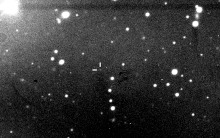Dia (moon)
Dia /ˈdaɪ.ə/, also known as Jupiter LIII, is a prograde irregular satellite of Jupiter. Provisionally known as S/2000 J 11, it received its name on March 7, 2015.[3] It is named after Dia, daughter of Deioneus (or Eioneus), wife of Ixion. According to Homer, she was seduced by Zeus in stallion form; Pirithous was the issue.
 Rediscovery images of Dia taken by the Magellan Telescope at the Las Campanas Observatory | |
| Discovery | |
|---|---|
| Discovered by | Scott S. Sheppard, David C. Jewitt, Yanga R. Fernández, and Eugene A. Magnier |
| Discovery site | Mauna Kea Obs. |
| Discovery date | 5 December 2000 11 September 2012 (rediscovery) |
| Designations | |
Designation | Jupiter LIII |
| Pronunciation | /ˈdaɪ.ə/[1] |
Named after | Δῖα Dīa |
| S/2000 J 11 | |
| Orbital characteristics [2] | |
| 12118000 km | |
| Eccentricity | 0.211 |
| +287.0 days | |
| 169.9° | |
| Inclination | 28.23° |
| 290.9° | |
| 178.0° | |
| Satellite of | Jupiter |
| Group | Himalia group |
| Physical characteristics | |
Mean diameter | 4 km |
| 22.4 | |
The satellite is one of the three known small bodies in the Himalia group,[4] the other two being Ersa and Pandia.
Dia is thought to be about 4 kilometres in diameter.[5] It orbits Jupiter at an average distance of 12 million km in 274 days, at an inclination of 28° (to Jupiter's equator), and with an eccentricity of 0.21.[6]
Observational history

Dia was discovered by a team of astronomers from the University of Hawaii led by Scott S. Sheppard in 2000 with an observation arc of 26 days.[7][8]
Initial observations were not followed up, and Dia was not observed for more than a decade after 2000. This apparent disappearance led some astronomers to consider the moon lost.[9] One theory was that it had crashed into Himalia, creating a faint ring around Jupiter.[10] However, it was finally recovered in observations made in 2010 and 2011.[6]
References
- Noah Webster (1884) A Practical Dictionary of the English Language
- S.S. Sheppard (2019), Moons of Jupiter, Carnegie Science, on line
- CBET (Central Bureau Electronic Telegram) 4075: 20150307: Satellites of Jupiter, March 7, 2015
- Sheppard, S. S.; Jewitt, D. C.; An abundant population of small irregular satellites around Jupiter Archived August 13, 2006, at the Wayback Machine, Nature, 423 (May 2003), pp. 261–263
- Sheppard, S. S.; Jewitt, D. C.; Porco, C.; Jupiter's outer satellites and Trojans Archived June 14, 2007, at the Wayback Machine, in Jupiter: The planet, satellites and magnetosphere, edited by Fran Bagenal, Timothy E. Dowling, William B. McKinnon, Cambridge Planetary Science, Vol. 1, Cambridge, UK: Cambridge University Press, ISBN 0-521-81808-7, 2004, pp. 263-280
- Williams, Gareth V. (September 11, 2012). "MPEC 2012-R22 : S/2000 J 11". Minor Planet Center. Retrieved September 11, 2012.
- Daniel W. E. Green (January 5, 2001). "IAUC 7555: Satellites of Jupiter". International Astronomical Union.
- Brian G. Marsden (January 15, 2001). "MPEC 2001-A29: S/2000 J 7, S/2000 J 8, S/2000 J 9, S/2000 J 10, S/2000 J 11". International Astronomical Union Minor Planet Center.
- "FAQ: Why don't you have Jovian satellite S/2000 J11 in your system?". JPL Solar System Dynamics. Retrieved February 13, 2011.
- "Lunar marriage may have given Jupiter a ring", New Scientist, March 20, 2010, p. 16.(subscription required)
External links
- Natural Satellites Ephemeris Service Minor Planet Center
- Planetary Satellite Mean Orbital Parameters NASA JPL
- Scott Sheppard pages
- David Jewitt pages